Bedridden Patient Height Calculator
If you're a caregiver, and you've ever asked yourself a question like 'How do I measure height in bedridden patients?' or 'How to estimate height without standing?' you're in the right place. Our height and weight measures in bedridden patients calculator allows you to estimate both weight and height in immobile patients. Read on to learn more about formulas for estimating height and weight, how to perform specific body measurements, and the alternatives to standing height measurements.
💡 Did you know you can predict the future height of the child, knowing their parents' height?
We try our best to make our Omni Calculators as precise and reliable as possible. However, this tool can never replace a professional doctor's assessment. If any health condition bothers you, consult a physician.
How to use height and weight measures in bedridden patients calculator?
Here's how to use our height and weight in bedridden patients calculator:
-
Look at the calculator panel. You have two sections: one about height, the other regarding weight. Decide what you want to work on first (although you can use both parts simultaneously).
-
Let's reckon you want to determine immobile patient height.
-
Pick a research study you want to base the calculations on. There are multiple height estimating formulas.
-
After choosing the study, fill in the needed values. In every formula, you'll be requested to input a different set of data — mainly body measurements.
-
If you need help performing a particular measurement, you can always hover over its title to get detailed instructions.
-
Weight estimation works the same way.
-
That's it. You'll see your results right away. You can always try a few methods and compare the results.
How to perform measurements for the bedridden patient height calculator
How to estimate the height and weight of an immobile patient? In our calculator, you'll find the answer to that question. However, you'll need to measure certain values cooperating with a patient. Here's how to do it properly:
- Semi-span, or demi-span, or half-arm span
It's the distance between the middle of the sternal notch to the tip of the middle finger. The arm should be in line with the shoulders.
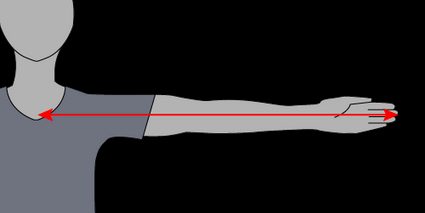
- Arm length
Measured from the rear side of the patient, it's the distance between the upper edge of the acromion process of the scapula and the bony part of the mid-elbow.
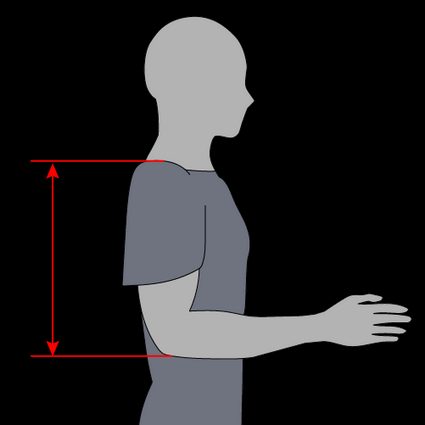
- Recumbent height (or crown-to-heel length)
It is the patient's height while they're recumbent; or the distance between the top of the head to the heels. It requires a special measuring scale.
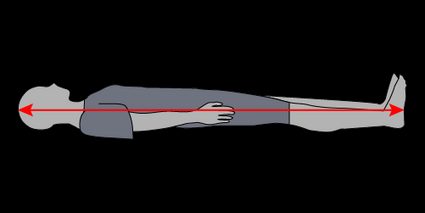
- Knee height
It is measured using a sliding caliper. The patient is lying supine with legs bare from just above the knee or sitting at the edge of a bed. One blade of a caliper is placed under the heel, and the other is placed on the anterior surface of the thigh.
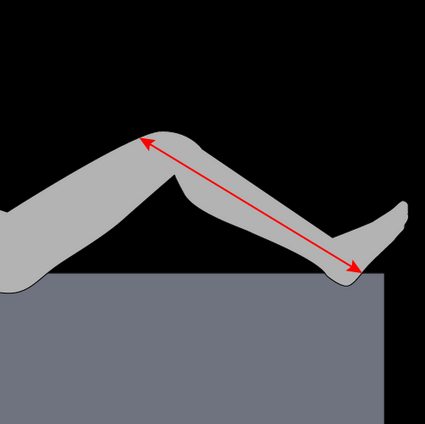
- Calf circumference
Take the measure in the non-dominant leg and aim for the widest circumference of the leg.
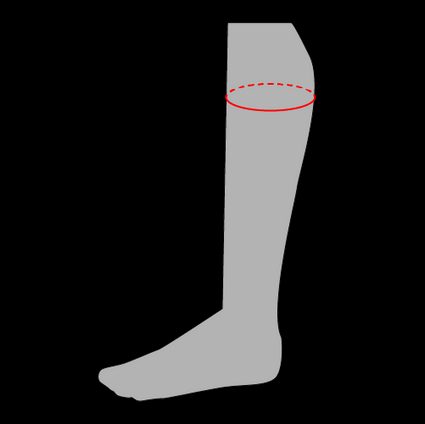
- Arm circumference
Measured in the mid-point of the arm, between the bony protrusion on the shoulder and the point of the elbow.
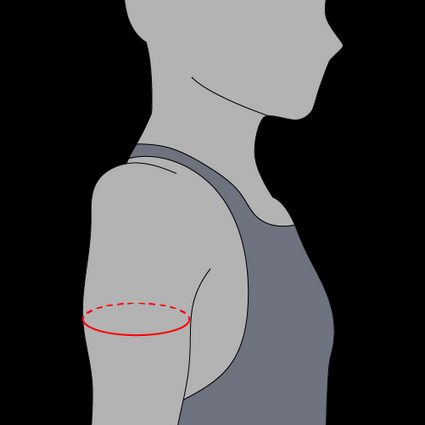
-
Subscapular skinfold thickness
You need a caliper for that measure. It's the diagonal fold just below the inferior angle of the scapula.Skinfold body fat calculator used to be a method to estimate a person's body fat. However, it's not seen as that valid anymore.
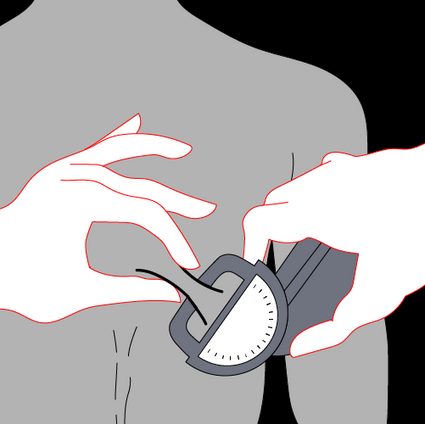
- Forearm length
The distance between the point of the elbow and the midpoint of the prominent wrist bone.
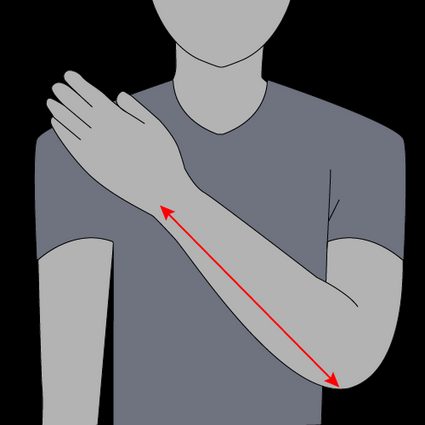
- Abdominal circumference
It's the circumference of your abdomen in the midpoint between the last rib and the bony part of your hip. The patient shouldn't be sucking in the stomach.
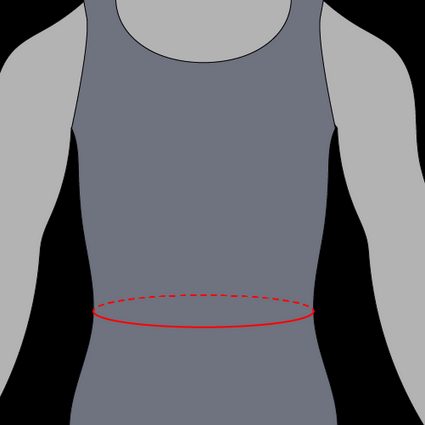
💡 Abdominal, or waist circumference, is an important indicator of health and should not exceed 102 cm in men and 88 cm in women. Visit waist to hip ratio calculator to learn more.
Estimating height formulas — how to estimate height without standing
Regarding alternatives to standing height measurements, luckily, we have quite a few options. See what formulas we're using to estimate the immobile patient's height:
-
Mitchell & Lipschitz formula
Height = Semi-span × 2 -
WHO formula (uses meters as a base unit)
Height = (0.73 × 2 × Half of arm span) + 0.43 -
Rabito et al. formula - two options
Height = 58.694 - (2.974 × Sex*) - (0.0736 × Age) + (0.4958 × Arm length) + (1.132 × Semi-span)or
Height = 63.525 - (3.237 × Sex*) - (0.06904 × Age) + (1.293 × Semi-span)* 1 — value for male; 2 — value for female.
-
Gray et al. formula
Height = Recumbent height -
Chumlea et al. formula
White women
Height = 70.25 + (1.87 × Knee height) - (0.06 × Age)Black women
Height = 68.1 + (1.86 × Knee height) - (0.06 × Age)White men
Height = 71.85 + ( 1.88 × Knee height)Black men
Height = 73.42 + (1.79 × Knee height) -
Cereda et al. formula
Height = 60.76 + (2.16 × Knee height) – (0.06 × Age) + (2.76 × Sex**)** 1 — value for male; 0 — value for female.
-
Knee height formula
Women
Height = 84.88 - (0.24 × Age) + (1.83 × Knee height)Men
Height = 64.19 - (0.04 × Age) + (2.02 × Knee height) -
Forearm formula
This is not a real equation but rather a chart. For every forearm (ulna) measurement of a person of certain sex and age, there is a corresponding estimated height. See more in the corresponding section.
-
Demi-span formula
Women
Height = (1.35 × Demi-span) + 60.1Men
Height = (1.4 × Demi-span) + 57.8
If not marked differently, all the length measurements are in centimeters (cm), and the age is in years.
Estimating weight formulas (without actually standing on a scale)
When a patient cannot stand, and you don't have a special scale to lay on, estimating weight formulas is the only way to figure out the person's weight. Here are the equations we use in height and weight measures in the bedridden patients calculator:
-
Chumlea et al. formula
Women
Weight = (1.27 × Calf circumference) + (0.87 × Knee height) + (0.98 × Arm circumference) + (0.4 × Subscapular skinfold thickness) - 62.35Men
Weight = (0.98 × Calf circumference) + (1.16 × Knee height) + (1.73 × Arm circumference) + (0.37 × Subscapular skinfold thickness) - 81.69 -
Rabito et al. formula — three options
Weight = (0.503 × Arm circumference) + (0.5634 × Abdominal circumference) + (1.318 × Calf circumference) + (0.0339 × Subscapular skinfold thickness) - 43.156Weight = (0.4808 × Arm circumference) + (0.5646 × Abdominal circumference) + (1.316 × Calf circumference) - 42.245Weight = (0.5759 × Arm circumference) + (0.5263 × Abdominal circumference) + (1.2452 × Calf circumference) - (4.8689 × Sex*) ± 32.9241* 1 — value for male; 2 — value for female.
-
Ross laboratories formula
White women
Weight = (1.01 × Knee height) + (2.81 × Arm circumference) - 66.04Black women
Weight = (1.24 × Knee height) + (2.81 × Arm circumference) - 82.48White men
Weight = (1.19 × Knee height) + (3.21 × Arm circumference) - 86.82Black men
Weight = (1.09 × Knee height) + (3.14 × Arm circumference) - 83.72
If not marked differently, all the length measurements are in centimeters (cm), and the weight is given in kilograms (kg).
Forearm length based height estimation charts
If you want to use the forearm (ulna) length to estimate the patient's height, use the table below. Measure the forearm length, and find the corresponding height depending on the sex and age of the patient.
Height (cm) - men <65 yrs | 146 | 148 | 149 | 151 | 153 | 155 | 157 | 158 | 160 | 162 | 164 | 166 | 167 | 169 | 171 | 173 | 175 | 176 | 178 | 180 | 182 | 184 | 185 | 187 | 189 | 191 | 193 | 194 |
|---|---|---|---|---|---|---|---|---|---|---|---|---|---|---|---|---|---|---|---|---|---|---|---|---|---|---|---|---|
Height (cm) - men >65 yrs | 145 | 146 | 148 | 149 | 151 | 152 | 154 | 156 | 157 | 159 | 160 | 162 | 163 | 165 | 167 | 168 | 170 | 171 | 173 | 175 | 176 | 178 | 179 | 181 | 182 | 184 | 186 | 187 |
Ulna length (cm) | 18.5 | 19.0 | 19.5 | 20.0 | 20.5 | 21.0 | 21.5 | 22.0 | 22.5 | 23.0 | 23.5 | 24.0 | 24.5 | 25.0 | 25.5 | 26.0 | 26.5 | 27.0 | 27.5 | 28.0 | 28.5 | 29.0 | 29.5 | 30.0 | 30.5 | 31.0 | 31.5 | 32.0 |
Height (cm) - women <65 yrs | 147 | 148 | 150 | 151 | 152 | 154 | 155 | 156 | 158 | 159 | 161 | 162 | 163 | 165 | 166 | 168 | 169 | 170 | 172 | 173 | 175 | 176 | 177 | 179 | 180 | 181 | 183 | 184 |
Height (cm) - women >65 yrs | 140 | 142 | 144 | 145 | 147 | 148 | 150 | 152 | 153 | 155 | 156 | 158 | 160 | 161 | 163 | 165 | 166 | 168 | 170 | 171 | 173 | 175 | 176 | 178 | 179 | 181 | 183 | 184 |
FAQs
How to estimate height without standing with the WHO formula?
To calculate height:
-
You need to provide the half-arm span length. Let's say it's equal to 91 cm.
-
WHO formula:
Height [m] = (0.73 × 2 × Half of arm span) + 0.43 -
Convert the half-arm span to meters:
91 cm = 0.91 m
-
Plug in the value:
Height = (0.73 × 2 × 0.91) + 0.43 = 1.76 -
Height is equal to 1.76 m. You can double-check with the bedridden patient height calculator.
What are the formulas for estimating weight?
Formulas for estimating weight include:
- Chumlea et al. formula (you need: arm circumference, calf circumference, knee height, and subscapular fold thickness);
- Rabito et al. formula (measurements needed: arm circumference, calf circumference, and abdominal circumference); and
- Ross laboratories formula (you'll need the person's race, arm circumference, and knee height).
How to calculate height if the recumbent height is 167 cm?
The patient's height is 167 cm.
-
For that calculation, you can use Gray formula:
Height = recumbent height -
The actual height is equal to the recumbent height.
-
The units don't matter; you can use whichever is comfortable.
-
In our case:
Height = recumbent height = 167 cm
What are alternatives to standing height measurements?
Alternatives to standing are either measuring recumbent height using a special scale (following the Gray formula) or estimating height with one of the formulas:
- Mitchell & Lipschitz formula (uses semi-span length);
- WHO formula (uses half arm span length);
- Rabito et al. formula (needed: arm length and semi-span);
- Chumlea et el. formula (uses knee height);
- Cereda et al. formula (knee height again);
- Knee height formula;
- Forearm (ulna) length formula; or
- Demi-span formula.
How to measure the height and weight of an immobile patient?
The only way to measure the height and weight of an immobile patient without using specialized equipment is to measure indirectly. You can obtain certain measurements that don't require standing or forced positions, such as knee height, arm circumference, and many more. Check the formulas estimating height and weight and choose the most appropriate one.